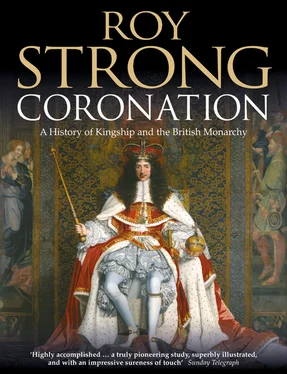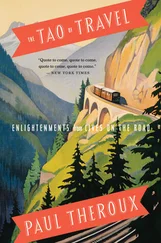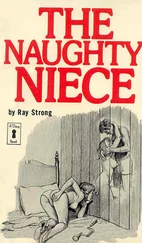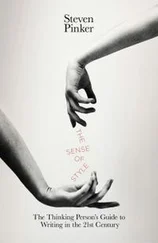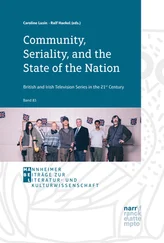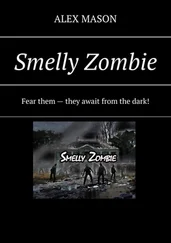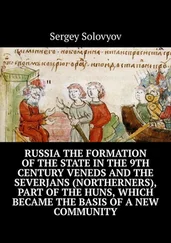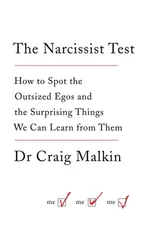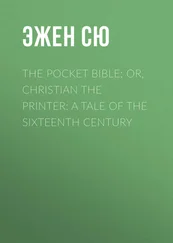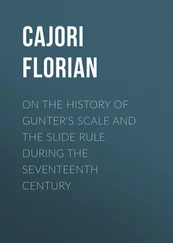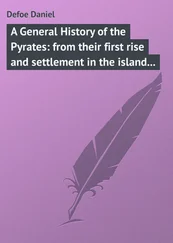CORONATION
FROM THE 8TH
TO THE 21ST CENTURY
ROY STRONG
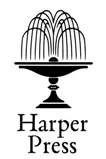
TO
THE DEAN AND CHAPTER
OF
WESTMINSTER
FROM
THEIR
HIGH BAILIFF
AND
SEARCHER OF THE SANCTUARY
2005
Cover
Title Page CORONATION FROM THE 8TH TO THE 21ST CENTURY ROY STRONG
PREFACE
Prologue 1953
1 The Lord’s Anointed
2 King and Priest
3 Kingship and Consent
4 Sacred Monarchy
5 Crown Imperial
6 From Divinity to Destruction
7 From Reaction to Revolution
8 Insubstantial Pageants
9 Imperial Epiphanies
Epilogue 2005
NOTES
BIBLIOGRAPHY
INDEX
CHRONOLOGY
Also by the Author
Copyright
About the Publisher
This book is a direct consequence of having the honour of holding the post of High Bailiff and Searcher of the Sanctuary at Westminster Abbey. It is a position lost in the mists of the medieval past when its orbit of activity was practical. Today the post, along with that of High Steward, is purely an honorary one – but not without purpose, for it enables the Dean and Chapter to draw into the Abbey’s service those who might bear witness to the faith it upholds and the ideals of the nation that it has come to epitomise. This book is my contribution.
It is a remarkable fact that the history of the English Coronation, particularly in the modern period, remains such a neglected field of study. The pioneer work remains Percy Schramm’s still magisterial study published in English in 1937. To that we must add the recent monumental and definitive catalogue of the Crown Jewels in two vast volumes in a limited edition and hence inaccessible to the general public. The present book sets out to remedy that lack by providing both for the general and more specialised reader the first overall documented history of the Coronation in a single volume.
The need for such a publication is an urgent one as another Coronation will sooner or later take place. In researching and writing this book I have been struck by the widespread ignorance as to the nature of this ancient rite, au fond a foundation stone of the British state and a bulwark against its total secularisation. It is no empty pageant but one that, like so many other historic customs and institutions under attack today which some wish cheerfully to sweep away, has proved itself amazingly flexible over the centuries. Any nation calls for rites of passage and the Coronation, with its central concept of setting a single human being apart by dint of anointing with holy oil as the embodiment of both crown and nation, is the greatest of them all.
I began my scholarly life almost half a century ago working under the late Dame Frances Yates on Elizabethan court pageantry. At the time I confess to finding Coronations dull and, I thought, merely repetitious. How wrong I was! Researching this book has been one long revelation as the ceremonial inaugurating a new reign gradually revealed its ability to respond to and reflect every theological, political, social and cultural nuance over the centuries.
I do not claim to have written the last word on this subject. Who could? But I have opened up a topic that in some areas has already attracted fine scholarly contributions. My debt to those scholars, particularly those working on the early and medieval periods, I acknowledge with gratitude. One of the problems of working on this subject is the sheer quantity of the manuscript and printed material, so much that inevitably at some point a line firmly had to be drawn or else the book would never have been finished and the result would have been unwieldly. What is new is the attempt throughout to draw the camera’s lens back and place what can all too easily become an antiquarian account of a series of isolated pageants into the wider perspective of what those involved at the time were setting out to achieve.
Coronation could not have been written without recourse to manuscript material. In the case of the early, medieval and Tudor periods that has been fairly fully explored. It is the material for the modern period which has largely gone without investigation and it is that which in the main has preoccupied me. I cannot express my gratitude enough for the graciousness extended to me at all the archives explored to write this book: the College of Arms, the British Library, Westminster Abbey Muniments, Lambeth Palace Library, St John’s College, Cambridge and the Public Record Office. In the case of the last I am grateful to R. W. O’Hara who, under my direction, worked through the material there. From the outset, thanks to the enthusiastic support of Garter King of Arms, I was given unfettered access to the huge collections in the College. Robert Yorke, their librarian, saw that, each time I went, everything I asked for was to hand. Equally Dr Richard Mortimer and Dr Tony Trowles saw that I was fed with the plethora which exists in the Abbey. At St John’s College, Cambridge, I was looked after by Jonathan Harrison, the Special Collections Librarian.
The advent of the information technology revolution truly also facilitates far speedier research. The ability to consult the British Library catalogue online and so much of its manuscript holdings remains a constant source of wonder to me. What has also speeded research is that splendid British Library resource, Articles Direct, from their supply centre at Boston Spa.
I cannot list nor remember now everyone who has helped me on my way but I record my gratitude to the Lord Chamberlain, Lord Luce, who welcomed this project which meant that, with the gracious permission of Her Majesty The Queen, I was given free access to all the material at the College of Arms, in particularly that connected with 1953. Amongst others who have assisted I record: Dr Andrew Hughes (University of Toronto), Dr Simon Thurley (English Heritage), John M. Burton (Surveyor of the Fabric of Westminster Abbey), Professor David Sturdy (University of Ulster), Dr Pamela Tudor-Craig, Clare Browne (Victoria & Albert Museum), Dr Richard Barber, Daniel McDowell, The Hon. Lady Roberts (Royal Archives, Windsor Castle), and Anna Keay (English Heritage). Particular gratitude is owed to the Very Revd Dr Wesley Carr, Dean of Westminster, for reading the closing chapters and making several pertinent suggestions.
I am one of those authors who rather depends on an inspired and committed editor who is prepared, which is unusual, to read what I write as I go along. In Arabella Pike I had just that. Once finished a book passes into the hands of the publication team whom I would like also to thank, in particular the designer Vera Brice. She has had to cope with the decision, a welcome one, that this book should incorporate what in effect is the largest visual archive on the topic.
ROY STRONG
The Laskett
June 2005
On my dressing table rests a small leather box with a lid embossed in gold with a stylised crown and below it the date 1953. The graphics are unmistakably of the period we associate with the Festival of Britain, which indeed opened only two years before. At the time I was coming up to being seventeen and in the sixth form of Edmonton County Grammar School sited on the fastnesses of the North Circular Road. The box was a gift to every boy in the school on the occasion of the Coronation of Queen Elizabeth II. In it we were to keep our shirt studs, a fact which immediately dates the object to a now vanished sartorial era. The object is as fresh as the day on which I received it and I keep it to hand to remind me of my earliest memory of real spectacle, as I was one of the two young people from my school selected to be bussed into central London on the great day to stand on the Victoria Embankment and watch the great procession make its way to Westminster Abbey. The date was 2 June 1953.
Читать дальше
